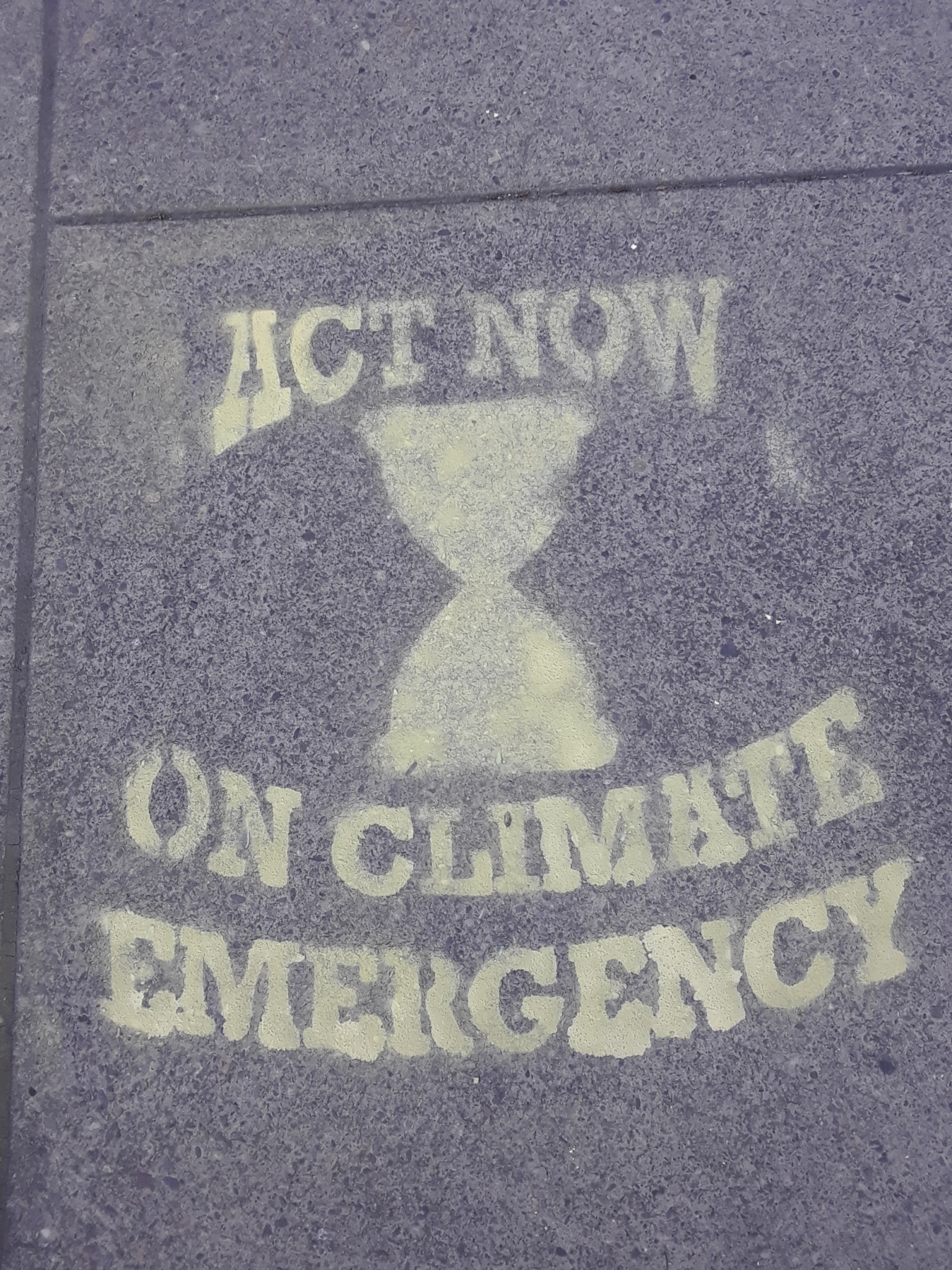In the two critical years since the passing of the Climate Emergency Declaration, the City can point to few, if any, concrete policies that will result in a substantive decline in emissions, which according to the IPCC needs to begin by 2025 and be halved by 2030. This is unacceptable. We need and demand specific action steps and measurable results.
What is labeled a “workplan” is a vaguely aspirational document, short on specifics. The CED first-year 2021 report was basically that as well; neither has resulted in concrete policies to reduce emissions. The City Council must create a Climate Emergency Commission with the best available experts and stakeholders to work with them on concrete action steps, measurable outcomes, and timelines to reduce the city’s greenhouse gas emissions.
Portland’s recent budget process in a SURPLUS year found the City government bragging about a .06% investment in climate related programs. Only a very small percentage of that is slated for emissions reductions or climate mitigation efforts, not very indicative of a full-blown Emergency Response. Many assumptions made in their decarbonization model need more information, and some of which could be challenged. The Police Bureau, which has its own airplane (why??), and other bureaus are omitted from this workplan, even though they consume a large percentage of general fund resources.
Only in the transportation sector does the workplan suggest anything close to a 50% reduction by 2030. Even there, the specific actions under T-1 and T-4 are very vague. Sixteen percent of their proposed transportation reductions rely on an update of the Renewable Fuel Standards. As research scientist Richard Plevin and other experts have pointed out, renewables come with their own set of climate issues. If the City is relying on the corporate nonsense that Zenith and other corporations quote on the emissions reductions levels, this is totally not to be trusted. That 16% reduction in the model needs to have assumptions carefully vetted, and the City needs to work with Dr. Plevin and others to set good policies that account for the complexity of renewable fuels. It is good that they plan to implement the Pricing Options for Equitable Mobility (POEM) recommendation: a 20-cent fee on parking meter transactions to send an initial price signal about the costs of driving. But we wonder about the timeline for various parts of that, which include:
- Expanding affordable housing Transportation Wallet
- BIKETOWN for All
- Multimodal infrastructure projects
- Research and policy development to inform additional pricing, equitable mobility, demand management, and affordability programs
BIOFUELS: Part of the City’s climate action work plan relies on “replacing petroleum diesel at the pump.” The council is requesting “update the renewable fuels standards.” While updating the renewable fuels standards great care must be taken to study this first, and be very cautious about relying on renewable fuels or bio-diesel. There are many different types of renewable fuels and biodiesel, which include major issues. Some of these can actually have a greater negative impact on climate. Biofuel is NOT a silver bullet.
Some of the issues:
- Induced land use change – cutting down forest to plant fuel stocks, or replacing crops grown for food with crops grown for fuel
- Can have harmful emissions same as fossil fuels
- Similar explosive hazards, does not belong in an earthquake liquefaction zone
- Easy way for fossil fuel infrastructure companies to hide fossil fuel activity; Zenith Energy is doing just that
- Having more bio-fuels to the mix may drop prices so people will just use more of all fuels
- Fossil fuels used to grow the feedstock cropsoften have higher climate impacts than the biofuels produced from those crops
We need to transition away from burning stuff to get around, whether fossil fuels or biofuels.
Few concrete emission reduction actions are presented in the Buildings sector and what they actually will do (for example in B1 and B2) in terms of emissions reductions. We have concerns from our participation in the Build Shift process. See below under B2 there is talk about eliminating carbon in City operations but again no concrete action plans, measurables, or timeline.
The Industry section is incomplete and unacceptable. Behind the scenes the City Council killed off the Portland Clean Air Protection Program. Businesses and industry should not be able to get off the hook for the next 10 years with no expected reductions in emissions. That’s ludicrous. The City needs to institute some sort of emissions fees policy asap.
TREES: We are disappointed in the vagueness of the sequestration and trees section of this document. Despite calls by the Shade Equity Coalition, there is no mention of street tree planting maintenance. The new Parks tree planting program is committing to less than half of the number of plantings that Friends of Trees has done in the past. Most importantly, there is no commitment to inventory and preserve giant old trees and community shade equity and sequestration resources, even if they are on private property. Waiting two years to begin the tree code revision process is unacceptable unless a moratorium is placed on the cutting of old giants. Look at what Milan, Italy is doing: planting 3 million trees –strategically – by 2030. Can’t we do better?
CONCERNS ON BUILD SHIFT: We are concerned that discussion was tending to point towards 2026 as the Build Shift implementation target for carbon emissions reductions, since science says there needs to be a significant downturn in emissions no later than 2025 and halved by 2030. Pushing back timelines will result in serious consequences. A ratcheting-down approach of annual decreases starting now is critical, as benefits from reductions will not be seen quickly. We agree with the concept of incentivizing early action. The City needs to have policies in place that will begin a downward decline as soon as possible through private/public partnerships, as well as encouraging the use of PCEF funds in this critical arena.
BUILDINGS: Since there is baseline data on commercial buildings, we would recommend plans to start there in 2023 with commercial buildings of 20K square feet (sf) and above, then phase in 10K sf commercial buildings and 20K sf large multifamily rentals two years later, eventually going to 5-unit buildings before 2030. As soon as possible, put into place Resource Centers for both owners and renters.*
TENANT/LANDLORD SOLUTIONS: While we understand the systems life cycle benefits of a customized, internal-based approach to emissions decline, we are concerned both about the ongoing energy cost burden on tenants (ranging from 18-45% of necessary budget expenditures) as well as not adequately reducing emissions on the schedule required by climate science. Landlords should not be able to continue to defer maintenance or delay as long as possible the big ticket items. Short intervals of 2-3 years requiring 10-15% emissions declines in each interval are recommended.
However, we also recommend allowing flexibility in terms of how building owners are going to achieve these reductions, through a customized approach addressing lighting, building envelope upgrades, mechanical upgrades, operations upgrades, and the like, benefitting from cost savings that can be utilized for additional upgrades. Compliance fees will ensure that owners remain on task in meeting building performance standards. Likewise, inspections and compliance certification processes need to be developed. Any owner support should have tenant protection agreements both to prevent displacement or owners passing along higher costs.
METHANE: The City should work with Multnomah County to develop health standards to prevent “natural gas” (methane) appliances in new construction (as is being done in NY, CA and Eugene) and begin phasing out natural gas from existing homes. Science makes clear that ventilation and even filtration are not sufficient solutions to the health and climate issues posed by methane, particulate matter, and nitrous oxide. Other communities are working to provide small heating and cooling geothermal districts using existing natural gas infrastructure as a possible transition. The City should work with the County on this for indoor air quality as well as emission reductions. Any cooling standards developed must ensure that cooling sources are energy-efficient and not adding substantially to climate impacts. We support heat pumps, safe renewables, passive designs, and conservation methods to ensure that the long-range costs and climate and health consequences for tenants are not adding harm.
COMMUNITY ENERGY SOLUTIONS: The City should immediately begin work on Community Controlled Local Capture and Storage Energy programs, and be ready to increase the percentage they commit to in this, especially if the utilities are not on track. All decarbonization efforts must involve workforce development aspects so that the green transition creates living wage family jobs and clear career paths for advancement, especially for marginalized communities.
ENERGY: The City makes a huge point out of the necessity of decreasing energy supply from fossil fuels towards clean renewable sources. The focus is on Portland General Electric which may be around 2/3rds of Portland’s households — this is based on comparing service areas, although Pacific Power area of N/NE Portland is denser than areas of the West Hills for example. Pacific Power’s parent company PacificCorps presents misleading information on their renewable claims for Portland area, given that PacificCorps’ plan for western states is to continue to burn coal for years, then transition primarily to natural gas and nuclear.
PGE plans to continue their Colstrip, MT coal mine units 3 and 4 until 2034. PGE’s 2019 Integrated Resource Plan (IRP) states its emissions will still amount to about 4+ million metric tons (MMT) of CO2 in 2030, 2.5 MMT of CO2 in 2040, and almost 2 MMT of CO2 in 2050. More detailed study of utility IRPs will be needed to see how they expect to get to the promised transition. A huge gap falls between what is promised here and whether or not utilities will meet the state’s Climate Protection Plan goals (which are not strong enough according to the more recent IPCC reports), especially since the utilities are actively fighting these in court. The City should immediately begin work on Community Controlled Energy programs, and be ready to increase the percentage they commit to.
WHAT OTHER PLACES ARE DOING: The City should look at what other cities and states are actually implementing as they consider their own action plan! Communities in California have created their own energy districts and utilize the profits for the common good—climate and social justice. Kauai, Hawai’i has brought consumer energy costs down by focusing on community solar and reselling residential and offpeak surplus to other utilities or businesses. Portland can and must do better!
[Photo credit: Janet Weil]

